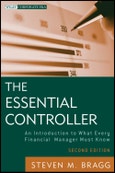Designed to give new controllers a firm foundation in the concepts of managing the accounting department, locating GAAP information, and analyzing and knowing what to do with key accounting information, The Essential Controller, Second Edition is the invaluable primer you can turn to for the foundation you need to succeed. Whether your business is large, small, or medium-sized, this volume provides a complete overview of the controller's responsibilities and the role that today's controllers should be playing.
- Offers new coverage of finance strategy
- Updates taxation strategy
- Includes a new controller checklist
- Quick reference guide that controllers can turn to
- Also by Steven M. Bragg: The Controller's Function: The Work of the Managerial Accountant, Fourth Edition
The Essential Controller, Second Edition is the go-to handbook that you will use every day for dealing with the everyday issues facing today's controllers.
Table of Contents
Preface ixChapter 1 Accounting in the Corporation 1
Importance of This Chapter 1
Tasks of the Accounting Function 2
Role of the Accounting Function 5
Role of the Controller 6
Impact of Ethics on the Accounting Role 8
Evolving Role of Accounting 12
Chapter 2 Controller’s Responsibilities 13
Importance of This Chapter 13
Variations on the Title 14
Planning Function 14
Control Function 16
Reporting Function 17
Accounting Function 17
Additional Controller Functions in Smaller Companies 18
Controller’s Job Description 22
Relationship of the Controller to the Chief Financial Of cer 24
Future Changes in the Controller’s Origins and Responsibilities 26
Managing Rapid Growth 28
Chapter 3 Chief Financial Of cer: From Controller to Facilitator of Change 31
Importance of This Chapter 31
Understanding What Chief Executive Of cers Want 32
Task of the CFO 32
Develop and Communicate a Compelling Finance Agenda 33
Build a Commitment to Change within Finance 36
Change Executive Management Practices 40
Enlist the Support of the Chief Executive Of cer 42
Mobilize the Organization 44
Institutionalize Continuous Improvement 46
Chapter 4 Operational Accounting 49
Importance of This Chapter 49
Create Departmental Job Descriptions 50
Create a Departmental Training Program 52
Clear Out Excess Documentation 55
Streamline the Accounting Work- ow 56
Document All Major Processes 58
Correct the Underlying Causes of Errors 59
Use Best Practices 62
Outsource Selected Accounting Functions 64
Chapter 5 Cost Accounting and Costing Systems 71
Importance of This Chapter 71
Purpose of Cost Accounting Information 72
Input: Data Collection Systems 73
Processing: Data Summarization Systems 77
Processing: Job Costing 79
Processing: Process Costing 87
Processing: Standard Costing 90
Processing: Direct Costing 93
Processing: Throughput Costing 96
Processing: Activity-based costing 101
Processing: Target Costing 103
Outputs: Cost Variances 107
Chapter 6 Ratio and Trend Analysis 113
Importance of This Chapter 113
How to Use Ratios and Trends 114
A Caveat 115
Measures for Pro tability 118
Measures for the Balance Sheet 122
Measures for Growth 128
Measures for Cash Flow 129
Measures for Non nancial Performance 132
Interrelationship of Ratios 152
Setting Up a System of Ratios and Trend Analyses 154
Chapter 7 Internal Control Systems 157
Importance of This Chapter 157
Objectives 158
Responsibility for Internal Controls 159
Examples of Internal Controls 161
When to Eliminate Controls 164
Types of Fraud 167
Preventing Fraud 169
How to Deal with a Fraud Situation 174
Foreign Corrupt Practices Act 176
Chapter 8 The Fast Close 179
Importance of This Chapter 179
Different Types of Fast Close 180
How to Achieve a Fast Close 181
Enhanced Closing Process 196
Chapter 9 Internal Audit Function 197
Importance of This Chapter 197
Reporting Relationships 198
Composition of the Audit Committee 199
Role of the Audit Committee 201
Internal Audit Objectives 203
Internal Audit Activities 206
Managing the Internal Audit Function 209
Chapter 10 Recruiting, Training, and Supervision 215
Importance of This Chapter 215
Recruiting Sources 216
Factors to Consider When Recruiting 219
Factors to Consider When Promoting 221
Importance of Reduced Turnover 223
Importance of Developing Career Plans for Employees 228
Importance of Communications with Employees 231
How to Motivate Employees 233
Chapter 11 Controller’s Role in Investor Relations 235
Importance of This Chapter 235
Objectives of the Investor Relations Function 236
Evolving Nature of the Function 237
Communication Vehicles for
Investor Relations 238
Investor Relations Message Recipients 239
Information Needs of the Financial Analyst 240
Information Needs of Other Groups 243
Disclosure Policy 243
Organization Structure for Investor Relations 245
Role of the Controller and Other Principals 246
Some Suggested Financial Market Objectives 250
Some Suggested Methods 251
Chapter 12 Taxation Strategy 253
Importance of This Chapter 253
Accumulated Earnings Tax 255
Cash Method of Accounting 256
Inventory Valuation 257
Mergers and Acquisitions 258
Net Operating Loss Carryforwards 259
Nexus 261
Project Costing 262
Property Taxes 262
S Corporation 263
Sales and Use Taxes 264
Transfer Pricing 266
Unemployment Taxes 269
About the Author 271
Index 273








